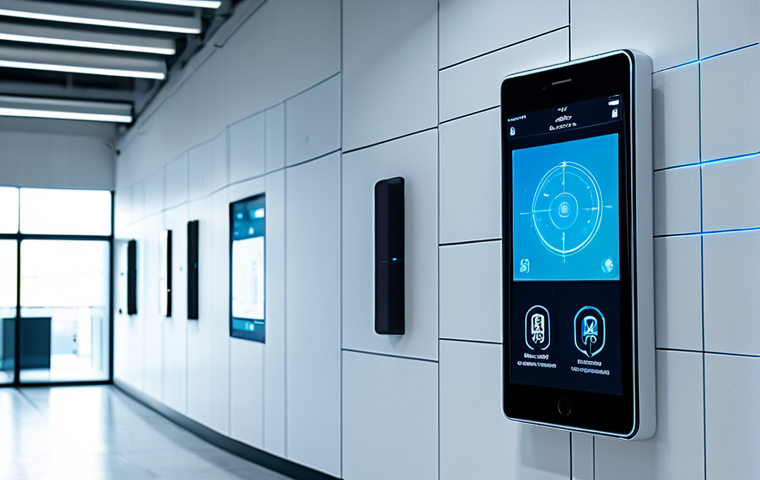Fire safety management has always been about protecting lives and assets, a responsibility that weighs heavily on anyone in the field. Yet, what truly excites me lately is how dramatically this critical area is being transformed by technology.
We’re moving far beyond just smoke detectors and sprinkler systems; we’re witnessing a paradigm shift where cutting-edge innovations are making our buildings smarter and infinitely safer, anticipating dangers before they even manifest.
It’s no longer just about reacting to emergencies, but preventing them entirely with unprecedented precision. Let’s explore it in detail below. Honestly, I remember when fire safety felt like a largely reactive discipline, relying heavily on manual checks and post-incident analysis.
But seeing how AI and IoT are now literally revolutionizing how we prevent and respond to fires is just mind-blowing. Think about it: tiny, sophisticated sensors are now capable of detecting minute changes in air composition or heat signatures, flagging potential risks long before a traditional alarm would even chirp.
Artificial intelligence crunches this massive influx of data, predicting potential hot zones or identifying unusual patterns in building occupancy, effectively turning static structures into responsive, self-aware entities.
This isn’t merely an upgrade; it’s a fundamental change in our approach, allowing us to be truly proactive and, most importantly, save lives by mitigating risks well before they escalate into emergencies.
It’s truly a game-changer.
The Dawn of Predictive Analytics: Turning Data into Lifesaving Insights

The sheer volume of data we can now collect from a building is staggering, and honestly, it’s a game-changer. I remember years ago, our analysis was often reactive – looking at what happened *after* a fire to understand the cause.
Now, with predictive analytics, we’re able to sift through environmental data points, occupancy trends, even historical weather patterns, to anticipate potential risks before they even begin to smolder.
It’s like having a crystal ball, but one powered by algorithms and real-time information. For someone like me, who’s spent a career trying to mitigate disasters, this proactive capability feels like a monumental leap forward.
We’re talking about not just detecting smoke, but understanding the subtle shifts in air quality, temperature fluctuations, or unusual electrical signatures that indicate a problem is brewing.
This granular level of insight allows for incredibly targeted interventions, often preventing small issues from escalating into full-blown emergencies.
It truly transforms fire safety from a reactive measure into a predictive science, giving us a far better chance to protect lives and property. It’s exhilarating to see this evolution unfold in real-time within the industry.
1. Leveraging AI for Anomaly Detection
Artificial intelligence is the real workhorse here, sifting through millions of data points from various sensors that would overwhelm any human operator.
I’ve seen systems that learn the normal operational patterns of a building – its typical heat signatures, air quality benchmarks, and even the usual flow of people during different times of the day.
When something deviates from this learned normal, even slightly, the AI flags it. For instance, an unusual heat signature in an unoccupied storage room late at night, or an abnormal increase in particulate matter in the air.
This isn’t just about a single sensor tripping; it’s about the holistic understanding of a building’s ‘health.’ I recall a scenario where an AI system flagged a subtle temperature increase in a data server room long before it reached critical levels, prompting an investigation that uncovered a faulty power supply unit.
Without the AI, that would have likely gone unnoticed until it became a much bigger, more dangerous problem. It’s about catching the whispers before they become shouts.
2. Dynamic Risk Profiling and Adaptive Responses
What truly fascinates me is how these systems are not static. They constantly learn and adapt, creating a dynamic risk profile for each part of a building.
This means that an AI might recognize that a certain area, perhaps a kitchen during peak hours, naturally has higher heat or smoke levels, and adjust its sensitivity accordingly.
Conversely, a seldom-used electrical closet might trigger a high alert for even a minimal temperature increase. This dynamic profiling allows for more accurate alerts and fewer false alarms, which, as anyone in fire safety knows, is absolutely crucial.
False alarms can lead to complacency and wasted resources. By understanding the context and severity of potential threats in real-time, these systems enable building management and emergency services to implement truly adaptive responses, allocating resources where they are most needed and at the precise moment they are most effective.
It’s a level of nuance we could only dream of just a decade ago.
IoT’s Unseen Sentinels: Networks of Smart Sensors
Stepping into a modern building, you might not see them, but they’re everywhere: tiny, unassuming IoT sensors, working tirelessly, acting as unseen sentinels.
From smart smoke detectors that differentiate between cooking fumes and actual fire, to sophisticated thermal cameras that can pinpoint exact heat sources through smoke, these devices are the backbone of today’s intelligent fire safety systems.
I’ve always been a proponent of comprehensive coverage, and these interconnected networks provide exactly that. It’s no longer about individual alarms sounding in isolation; it’s about a symphony of data flowing from every corner of a structure, creating a holistic picture of its internal environment.
The beauty of IoT lies in its connectivity; these sensors don’t just detect, they communicate. They talk to each other, they talk to central monitoring systems, and increasingly, they talk directly to first responders, providing vital, real-time intelligence that can make all the difference in an emergency.
This interconnectedness truly amplifies our protective capabilities.
1. Beyond Smoke: Multi-Sensor Detection
The traditional smoke detector was a revolutionary invention, no doubt, but today’s IoT devices take detection to a whole new level. We’re now deploying multi-sensor units that simultaneously monitor smoke, heat, carbon monoxide, volatile organic compounds (VOCs), and even humidity.
This comprehensive approach means we can identify a wider range of fire-related threats and, more importantly, differentiate between them. I’ve personally seen instances where an advanced sensor identified a smoldering electrical fire by detecting specific VOCs and a slight temperature increase, long before any visible smoke or significant heat would have triggered a conventional alarm.
This early detection capability is invaluable, offering precious extra minutes for evacuation and intervention. It’s not just about what burns, but how it burns, and these multi-sensors give us that nuanced understanding.
2. The Power of Integrated Communication
What sets IoT apart is its ability to integrate and communicate across vast networks. Imagine a system where a smoke detector in the basement not only triggers an alarm but also automatically sends data to the building’s HVAC system to shut down air circulation, notifies the local fire department with precise location data, unlocks emergency exits, and even activates a targeted sprinkler system in the affected zone.
This level of coordinated response, orchestrated by interconnected IoT devices, significantly reduces response times and enhances safety for occupants and emergency personnel alike.
I remember manually coordinating these steps in drills, but now, it’s all automated and instantaneous. It’s a beautiful thing to witness such seamless integration, truly embodying the spirit of “smart” safety.
AI: The Brains Behind the Bravery in Emergency Response
While sensors collect the data, artificial intelligence is the critical ‘brain’ that processes it, making lightning-fast decisions during an emergency.
It’s one thing to get a flood of information, but it’s another entirely to make sense of it under immense pressure. AI excels at this, analyzing complex scenarios in milliseconds, predicting fire spread, mapping evacuation routes in real-time, and even guiding emergency responders through smoke-filled corridors.
I’ve always admired the bravery of firefighters, but seeing how AI can augment their efforts, providing them with critical intelligence on the fly, is truly inspiring.
It removes some of the dangerous guesswork, allowing them to focus on their core mission of saving lives. This isn’t about replacing human intuition; it’s about providing human heroes with superhuman tools.
1. Real-time Evacuation and Navigation Assistance
In the chaos of an emergency, clear guidance is paramount. AI-powered systems can now process real-time data on fire location, smoke density, and occupant movement to dynamically identify the safest and quickest evacuation routes.
Imagine illuminated exit signs that change color based on real-time hazards, or a building’s public address system providing adaptive instructions. I’ve seen demonstrations where AI could even direct individuals with mobility impairments to accessible exits or areas of refuge based on their pre-registered profiles.
This level of personalized, real-time navigation assistance is revolutionary, helping people make the right choices under immense stress. It brings me immense peace of mind knowing that these systems can help guide people out of harm’s way with such precision.
2. Supporting First Responders with Intelligent Data
For firefighters entering a dangerous scene, every piece of information is vital. AI can now provide them with detailed schematics of a burning building, indicating the precise location of the fire, the likely path of its spread, the location of hazardous materials, and even the last known positions of occupants.
This intelligence is delivered directly to their mobile devices or even augmented reality headsets. I recall one incident where real-time sensor data, analyzed by AI, indicated a structural integrity issue in a particular section of a burning warehouse, allowing the incident commander to reroute personnel and prevent potential collapse injuries.
This kind of immediate, actionable intelligence drastically improves the safety and effectiveness of emergency operations. It’s about empowering our brave responders with knowledge.
| Technology Category | Key Benefits for Fire Safety | Example Application |
|---|---|---|
| Artificial Intelligence (AI) | Predictive analytics, anomaly detection, dynamic risk assessment, real-time decision support. | Identifies subtle changes in heat/air quality indicating potential fire, guides evacuation routes. |
| Internet of Things (IoT) | Interconnected sensors, multi-parameter monitoring, automated responses, remote oversight. | Smart smoke detectors differentiating between cooking fumes and fire, automated sprinkler activation. |
| Thermal Imaging/Drones | Rapid hazard identification, post-incident analysis, inaccessible area inspection. | Drones with thermal cameras identify hot spots in large, smoky buildings or after a fire. |
| Building Information Modeling (BIM) | Comprehensive digital twin of building, aids pre-planning and emergency navigation. | Provides firefighters with detailed structural layouts and utility shut-off locations. |
Drone Technology: Eyes in the Sky and Beyond
When I first heard about drones being integrated into fire safety, my initial thought was about their ability to provide an aerial view of a blaze. And while that’s incredibly valuable, the applications of drone technology have expanded far beyond just an elevated perspective.
These unmanned aerial vehicles are becoming indispensable tools, giving us access to areas too dangerous or inaccessible for humans, and providing critical intelligence in ways we could only imagine a few years ago.
The sheer speed and agility with which they can assess a developing situation from above, or even within a compromised structure, is simply phenomenal.
For someone who’s spent years on the ground, struggling with visibility and access during emergencies, the idea of having an ‘eye in the sky’ that can peer through smoke or assess structural damage without putting lives at risk is incredibly reassuring.
It’s truly a testament to how technology can amplify our human capabilities.
1. Rapid Assessment and Damage Control
During a large-scale fire, getting an immediate, comprehensive overview of the situation is paramount. Drones equipped with high-definition cameras, thermal imagers, and even gas detectors can provide real-time aerial footage, allowing incident commanders to quickly assess the extent of the fire, identify hot spots, and track its spread.
I’ve witnessed how this immediate visual intelligence has allowed fire departments to deploy resources much more effectively, targeting their efforts where they’re most needed and understanding the overall dynamics of the fire much faster than traditional methods.
This isn’t just about pretty pictures; it’s about critical data that informs strategic decisions, potentially saving lives and minimizing property damage.
It’s a tool that really puts the ‘rapid’ into rapid response.
2. Inspection of Inaccessible or Hazardous Areas
Beyond active fires, drones are revolutionizing routine inspections and post-incident assessments. Imagine inspecting the exterior of a high-rise building for structural weaknesses after a fire, or navigating through a smoke-filled, unstable factory to locate trapped individuals or hazardous materials.
Drones can perform these tasks without exposing human personnel to undue risk. They can enter collapsed structures, fly through vents, or even explore confined spaces, relaying crucial visual and sensor data back to operators.
This ability to safely gather information from dangerous environments is a game-changer for both proactive safety management and reactive emergency operations.
It means we can get eyes on things we otherwise couldn’t, improving both safety and efficiency for our teams.
Smart Building Integration: The Holistic Safety Ecosystem
What we’re truly moving towards, and what excites me most, is the concept of fully integrated smart buildings where fire safety isn’t just an add-on, but an intrinsic part of the structure’s operational DNA.
This means all systems – HVAC, lighting, security, access control, and, of course, fire detection and suppression – are seamlessly interconnected and communicate intelligently.
It’s no longer about disparate systems working in isolation; it’s about a unified, responsive ecosystem that can dynamically adjust to any threat. I’ve seen some incredible examples of buildings where, upon a fire alarm activation, not only do sprinklers deploy and alarms sound, but elevators automatically return to the ground floor, specific doors lock or unlock, ventilation systems alter airflow to contain smoke, and even digital signage updates with real-time escape routes.
This holistic approach significantly enhances the overall safety posture of a building, turning it into an active participant in its own defense.
1. Automated Response and Containment
The true power of smart building integration lies in its capacity for automated, coordinated responses. When a fire is detected, it’s not just a single alarm that sounds; it initiates a cascade of pre-programmed actions designed to contain the threat and protect occupants.
For instance, fire doors automatically close, compartmentalizing the building to prevent fire spread. HVAC systems can shut down or redirect airflow to create smoke-free zones or even pressurize stairwells, ensuring clearer escape paths.
I once visited a hospital that demonstrated how their smart system, upon detecting a fire in a specific wing, automatically isolated that area, initiated a targeted sprinkler release, and simultaneously diverted all incoming patients to a different, safe entrance, all without human intervention in the critical initial moments.
This level of automated, intelligent containment is literally saving lives by buying precious time.
2. Enhanced Occupant Safety and Experience
Beyond the immediate emergency response, smart building integration also dramatically improves the overall safety and experience for occupants. Think about buildings that can guide you to safety even if you’re unfamiliar with the layout, or those that have air quality sensors that can detect hazards beyond fire.
Moreover, the integration allows for more precise maintenance and testing of fire safety systems, often identifying potential failures before they occur, leading to fewer disruptions and a higher level of trust from occupants.
From my perspective, this proactive maintenance and seamless, intuitive guidance during an emergency provides an unparalleled sense of security. It’s about making safety intuitive and virtually invisible until it’s absolutely needed, which for me, is the mark of true innovation.
Closing Thoughts
As someone who has dedicated their career to fire safety, witnessing the rapid advancements in AI, IoT, drone technology, and smart building integration has been nothing short of transformative. What was once largely a reactive field, responding to disasters after they struck, is now becoming an incredibly proactive science, capable of anticipating and preventing tragedies before they even begin. It’s truly exciting to see how these intelligent systems are not only enhancing our ability to protect lives and property but are also empowering our brave first responders with unprecedented levels of real-time intelligence. My hope is that we continue to embrace these innovations, making our communities safer and more resilient than ever before.
Useful Information to Know
1. Regular Maintenance is Key: Even the smartest fire safety systems require routine checks and maintenance. Sensors can get dusty, batteries can die, and software updates are often crucial for optimal performance. Schedule professional inspections annually.
2. Consider Smart Home Integration: For homeowners, integrating smart smoke/CO detectors with your existing smart home ecosystem (like Google Home or Amazon Alexa) can provide immediate alerts to your phone, even when you’re away, and allow for remote monitoring.
3. Proactive Safety Saves Money: While initial investments in advanced fire safety tech might seem high, the cost savings from preventing major incidents, reducing false alarms, and potentially lowering insurance premiums can be significant in the long run.
4. Local Fire Departments are Adapting: Many fire departments across the U.S. and other English-speaking countries are actively researching and implementing these technologies. Support local initiatives that aim to modernize emergency response capabilities.
5. Understanding Your Building’s
Key Takeaways
The convergence of AI, IoT, drones, and smart building platforms is fundamentally reshaping fire safety. This technological evolution is moving us from reactive measures to predictive prevention, offering real-time insights and automated responses that drastically improve occupant safety and empower emergency responders. It’s about creating intelligent, interconnected environments that actively work to protect us, making our spaces safer and more resilient than ever before.
Frequently Asked Questions (FAQ) 📖
Q: So, you’re saying these buildings are becoming “self-aware”? How exactly does that work to prevent fires before we even smell smoke?
A: Oh, it’s wild, right? When I first heard “self-aware,” I pictured something out of a sci-fi movie, but it’s grounded in brilliant engineering. Imagine tiny, super-sensitive sensors tucked away, constantly ‘sniffing’ the air for even the faintest whiff of something wrong—maybe a spike in carbon monoxide or a slight shift in temperature that’s just not normal for that spot.
These aren’t just ‘on/off’ switches. They’re feeding a constant stream of data into an AI system that’s been trained on millions of hours of building activity and potential hazards.
It’s like having a hyper-vigilant, tireless guard dog for your building, but one that can also predict the future. It spots patterns, like an electrical circuit subtly overheating over hours, or an unusual heat signature from a device in an unoccupied office.
Instead of waiting for a fire to trigger a blaring alarm, the system flags it immediately to management or even automatically adjusts ventilation or power.
It’s about nipping potential issues in the bud, long before they become an emergency, which honestly, brings a level of peace of mind I never thought possible in this field.
Q: You mentioned it’s a “game-changer” compared to traditional methods. What’s the single biggest leap or advantage you’ve personally observed with this new proactive approach?
A: For me, hands down, the biggest leap is the shift from ‘response’ to ‘prediction.’ I mean, with traditional systems, bless their hearts, you’re essentially waiting for a fire to start.
A smoke detector needs actual smoke, a sprinkler needs actual heat. It’s like calling the ambulance after the accident. But with AI and IoT, we’re talking about predicting that accident and preventing it.
I’ve seen scenarios where the system flagged an unusual thermal signature from a forgotten laptop charger that was subtly overheating, hours before it could have sparked.
Or identified an anomaly in air quality that indicated a slow, silent gas leak. It’s the difference between merely reacting to a crisis and having the foresight to completely avert it.
That proactive capability, that ability to mitigate risks before they escalate into a full-blown emergency, is just… it’s invaluable. It’s not just about minimizing damage; it’s genuinely about saving lives that might have been lost in those crucial early moments.
Q: This sounds incredible, but are there any significant challenges or considerations that come with implementing such advanced technology in fire safety, from your perspective?
A: Oh, absolutely. No silver bullet ever is without its challenges, right? From my perspective, one of the first things that comes to mind is the sheer complexity of integrating all these disparate systems.
You’re talking about new sensors needing to talk to existing infrastructure, and legacy systems often don’t play nice. Then there’s the data: a massive amount of incredibly sensitive information about building occupancy, patterns, and potential weak points.
Ensuring robust cybersecurity and data privacy is paramount – you absolutely do not want that data falling into the wrong hands. And honestly, the cost is a factor for many building owners.
It’s a significant upfront investment, though the long-term ROI in terms of safety and avoided damage is undeniable. Finally, there’s the human element.
It’s not enough to just install the tech; you need highly skilled personnel who understand how to monitor, interpret the data, and maintain these sophisticated systems.
It’s an ongoing commitment, not a one-time fix. But despite these hurdles, the benefits vastly outweigh the difficulties, in my honest opinion.
📚 References
Wikipedia Encyclopedia
구글 검색 결과
구글 검색 결과
구글 검색 결과
구글 검색 결과
구글 검색 결과






